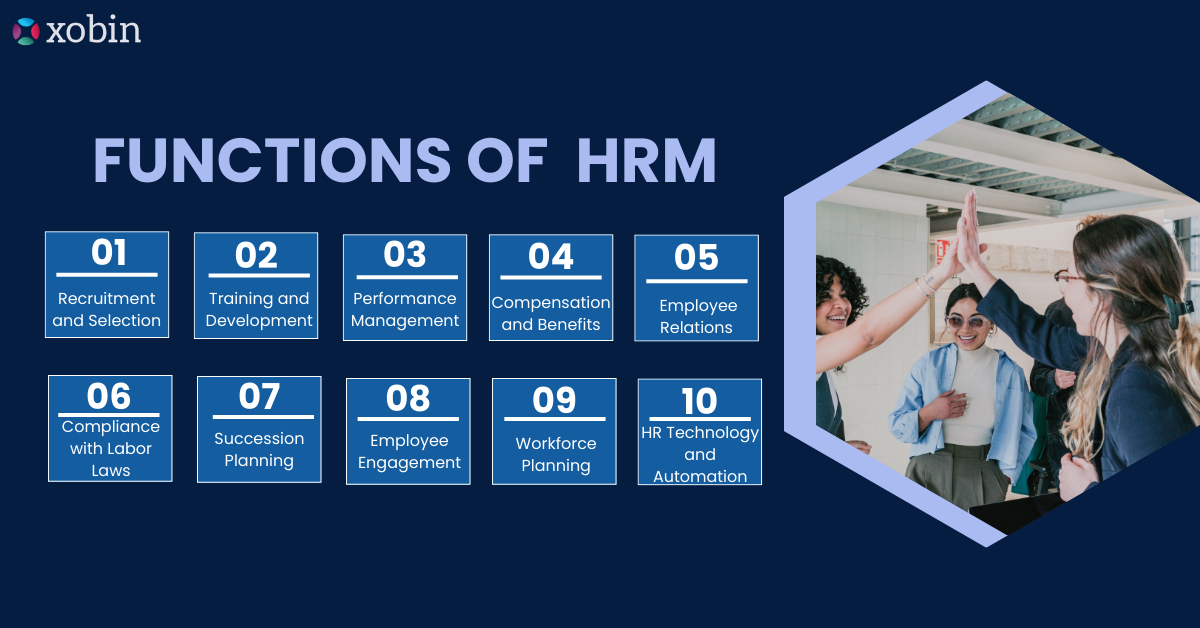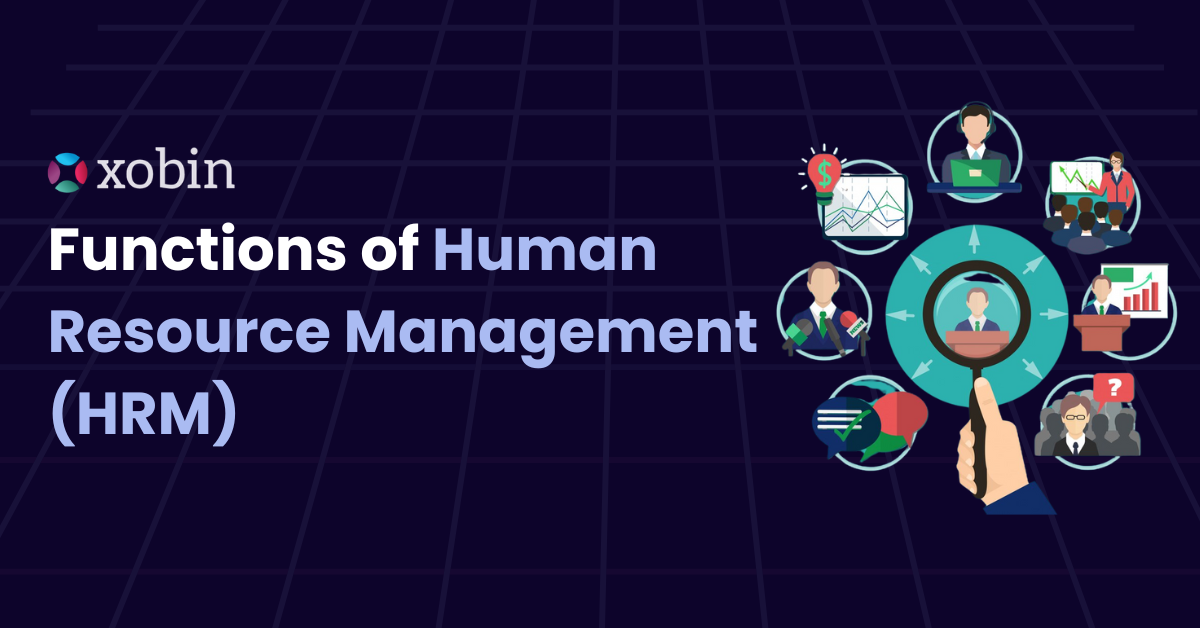Human Resource Management (HRM) plays a crucial role in shaping an organization’s success. It is responsible for hiring top talent, managing employee relations, ensuring compliance, and fostering a positive workplace culture. Effective HRM strategies help companies attract, develop, and retain employees who align with their goals and values. However, managing people is not just about recruitment, it involves multiple functions that contribute to long-term business growth. For recruiters, understanding the core functions of human resource management is essential.
Table of Contents
In this blog, we will explore the key HRM functions in detail and explain how they contribute to a company’s success. Whether you’re an HR manager or a recruiter, mastering these functions will help you improve hiring processes, boost productivity, and build a strong workforce.
Let’s explore the key functions of human resource management and how they impact recruitment!

1. Recruitment and Selection
Recruitment and selection serve as the backbone of HRM. An efficient hiring process attracts top talent while ensuring candidates align with company values and goals. Without a strong recruitment strategy, businesses face challenges in filling skill gaps, which leads to lower productivity and inefficiencies. The HR department actively develops strategies to identify, attract, and hire qualified candidates, strengthening the workforce and driving business success.
- Workforce Planning: Identifying the number and type of employees required based on business needs.
- Job Analysis and Description: Defining roles, responsibilities, and qualifications for each position.
- Sourcing Candidates: Posting job openings on job boards, social media, and recruitment platforms to reach potential candidates.
- Screening and Shortlisting: Reviewing resumes and conducting pre-employment skills testing to filter the most suitable candidates.
- Interviews and Evaluations: Conducting structured interviews, skills assessment tests, and background checks to select the right fit.
- Hiring and Onboarding: Offering positions to successful candidates and ensuring a smooth transition into the company.
2. Training and Development
Investing in continuous employee learning enables organizations to maintain a competitive edge. Additionally, robust training and development programs empower employees to acquire new skills, boost efficiency, and stay updated with industry trends. Consequently, companies that prioritize employee growth enjoy higher engagement and improved retention rates, ultimately driving overall business success.
- Orientation Training: Helps new hires understand company culture and expectations.
- Skill Development: Provides employees with role-specific training.
- Leadership Development: Prepares high-potential employees for managerial roles.
- Soft Skills Training: Enhances communication skills, teamwork, and problem-solving skills.
- Compliance Training: Ensures employees understand company policies and industry regulations.
3. Performance Management
Evaluating employee performance plays a key role in maintaining productivity and efficiency. A well-structured performance management system allows HR professionals to track employee contributions effectively. It also helps identify areas that need improvement, making it easier to implement targeted interventions. Additionally, this process ensures employees receive constructive feedback, which is vital for skill enhancement.
- Setting SMART goals: Establishes measurable targets for employees.
- Regular Feedback: Provides constructive reviews and performance discussions.
- Performance Appraisals: Evaluates employee contributions and identifies growth opportunities.
- Recognition Programs: Rewards employees for their achievements.
- Performance Improvement Plans: Addresses underperformance with structured development strategies.
4. Compensation and Benefits Management
Competitive compensation attracts and retains top talent. Employees seek fair wages, enticing incentives, and industry-standard benefits. To keep them engaged, HRM must design salaries and benefits that motivate while ensuring financial stability. Aligning compensation with market trends enhances employee satisfaction and strengthens loyalty.
- Salary Structure: Determines base pay based on skills and experience.
- Bonuses and Incentives: Encourages high performance with financial rewards.
- Health and Wellness Benefits: Provides medical insurance, gym memberships, and wellness programs.
- Retirement Plans: Offers pension schemes and long-term financial security.
- Paid Leaves and Perks: Includes vacation days, parental leave, and work-from-home options.
5. Employee Relations and Conflict Resolution
To maintain a harmonious workplace, HRM actively resolves disputes, handles employee grievances, and fosters conflict resolution. By addressing these issues early on, HRM prevents disruptions and supports a healthy, productive environment. This proactive approach helps to build strong work relationships and ensures smooth operations. Importantly, resolving conflicts early boosts team morale, creating a positive atmosphere in the workplace.
- Conflict Resolution: Mediates disputes between employees and managers.
- Employee Engagement Initiatives: Organizes team-building activities and feedback programs.
- Workplace Culture Development: Promotes inclusivity and collaboration.
- Employee Assistance Programs: Provides support for mental and emotional well-being.
- Open Communication Policies: Encourages transparency between employees and management.
6. Compliance with Labor Laws
To avoid legal issues and ensure fair employee treatment, organizations must comply with labor laws and regulations. HR departments play a crucial role in overseeing legal compliance. They ensure company policies align with both national and international labor laws, maintaining a strong framework for ethical operations.
- Workplace Safety Regulations: Adheres to OSHA and other safety standards.
- Equal Employment Opportunity (EEO): Prevents workplace discrimination.
- Payroll Compliance: Ensures accurate tax deductions and salary payments.
- Employment Contracts: Outlines legal obligations and employee rights.
- HR Policy Updates: Keeps company policies in line with evolving labor laws.
7. Succession Planning
An effective succession planning strategy helps businesses prepare for future leadership needs. It identifies high-potential employees and trains them for key roles. Consequently, this proactive approach ensures seamless business continuity while minimizing disruptions during leadership transitions.
- Talent Identification: Recognizes employees with leadership potential.
- Leadership Development Programs: Provides mentorship and executive training.
- Internal Promotions: Encourages career growth within the organization.
- Knowledge Transfer Strategies: Documents and shares critical business insights.
- Risk Mitigation: Reduces operational risks associated with leadership gaps.
8. Employee Engagement and Retention
Engaged employees drive an organization’s success by contributing more effectively. HRM boosts engagement by fostering clear communication, implementing recognition programs, and providing career development opportunities. When employees feel motivated, they become more productive and remain loyal to the company.
- Work-Life Balance Initiatives: Offers flexible work hours and remote work options.
- Career Development Opportunities: Provides employees with growth paths and promotions.
- Employee Recognition Programs: Celebrates achievements and contributions.
- Company Culture Building: Creates a supportive and collaborative workplace.
- Exit Interviews and Feedback: Identifies retention challenges and areas for improvement.
9. Workforce Planning and HR Strategy
Organizations actively implement strategic workforce planning to prepare for future talent needs and secure a competitive edge. Moreover, HR professionals analyze workforce trends, predict potential skill shortages, and design targeted talent acquisition strategies that align with core business objectives. As a result, these proactive measures ensure that the right talent drives long-term success and sustainable growth.
- Manpower Forecasting: Predicts future hiring needs based on business goals.
- Identifies skills gaps: Conduct skills gap analysis to identify areas where additional training is required.
- Workforce Restructuring: Aligns staffing levels with business objectives.
- Diversity and Inclusion Initiatives: Promotes a diverse and inclusive workplace.
- HR Technology Utilization: Uses AI-driven HR tools for data-driven decision-making.
10. HR Technology and Automation
Technology has revolutionized HR functions, making processes more efficient and data-driven. HR technology and automation streamline recruitment, performance management, and employee engagement. Companies leveraging AI-powered tools like Xobin enhance their HR efficiency significantly.
- ATS: Automates recruitment and candidate evaluation with Applicant Tracking System.
- HR Analytics: Provides insights into workforce trends and performance.
- Employee Self-Service Portals: Enables employees to manage their information.
- Chatbots for HR Support: Enhances employee assistance with AI-driven chat support.
- Performance Management Software: Tracks and evaluates employee progress efficiently.
Streamline Your HR Functions with Xobin!
Smarter Recruitment with Pre-Employment Assessments
Xobin’s skill assessment software allows you to assess candidate skills with pre-built and custom tests that are aligned to your specific job requirements. It offers a vast library of 2400+ job role based tests and 3400+ skills assessments covering technical, cognitive, and behavioral skills. These tests help recruiters identify top talent quickly and efficiently.
One-Way Video Interviews for Faster Screening
Speed up hiring with automated video interviews. Candidates can record their responses at their convenience, while recruiters can review them anytime. This saves time and effort, allowing HR teams to focus on the best-fit applicants.
Advanced Web Proctoring for Secure Hiring
Worried about cheating in online assessments? Xobin ensures fraud-proof hiring with its AI-powered advanced proctoring features. Our software detects screen activities, multiple faces, and suspicious behavior, ensuring test integrity.
Enhanced Candidate Experience
Xobin focuses on enhancing the candidate experience with an easy-to-navigate application process and real-time feedback. Candidates can take assessments on their terms, ensuring they stay engaged and excited about the opportunity. With personalized assessments tailored to the job, candidates experience a seamless and efficient recruitment journey.
Auto-Generated Reports and Analytics
Hiring decisions should be based on data, not guesswork. Xobin provides detailed performance analytics, skill gap analysis, and AI-generated advanced reports to help recruiters make informed hiring decisions.
Customizable and Scalable Solutions
Whether you’re hiring for a small team or scaling up rapidly, Xobin is flexible and customizable to meet your specific needs. From designing your own assessments to customizing the candidate experience, the platform ensures your recruitment process evolves with your company.
Collaborative Hiring Process
Xobin promotes team collaboration with its feedback-sharing capabilities. You can involve hiring managers and team members in the assessment and interview process, ensuring that you make decisions with collective input. This collaborative approach leads to better hiring decisions and helps create a more cohesive team.
If you’re looking for a complete recruitment solution. Discover how Xobin can help your team hire smarter, faster, and more effectively. Book a Personalized Demo today and experience the power of AI-driven talent assessment and HR technology!






